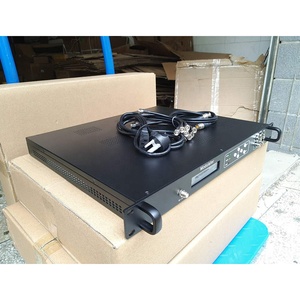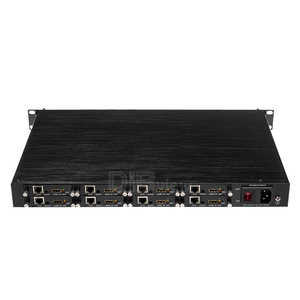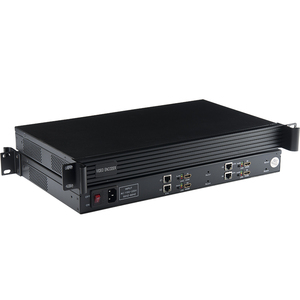(89 products available)

































































































































































Digital television (DTV) encoders are essential for converting uncompressed DTV signals into a transport stream. They perform digital modulation to broadcast or transmit DTV signals. DTV encoders come in different types depending on the signal source. A DTV encoder that compresses digital video is called an encoder, while a streaming encoder is referred to as a transcoder.
Generally, DTV encoders can be classified into two major categories:
Audio-video encoders convert standard audio and video streams into digital transmission so they can be efficiently broadcasted or transmitted. These encoders compress and encode video content in various resolutions to meet different audience preferences. The encoded programs are assembled into a transport stream for broadcasting over a specific medium.
Streaming transcoders receive an existing digital stream and convert it into another format or bitrate. They mainly work in live streaming and on-demand streaming services. Streaming transcoder encoders optimize the delivery of a video stream by adjusting its bitrate, resolution, or encoding format to suit a specific device or network condition.
DTV encoders can also be classified according to output standard into many other types:
The Advanced Television Systems Committee (ATSC) created a set of standards for digital television broadcast in North America. ATSC encoders are DTV encoders that adhere to these standards to ensure proper encoding and transmission of DTV signals in broadcast.
A DTV encoder has several important functions and features.
Digital Video Streaming
A digital video streaming is one of the most important functions of a DTV encoder. It encodes a video signal in real-time so that it can be broadcasted or streamed to viewers. The kind of encoding done depends on the bit rate and quality level of the video. The DTV encoder ensures that a viewer gets to see a high-quality video without any interruptions.
Multiplexing
The term multiplexing means combining. A DTV encoder has the multiplexing function, which enables it to combine different encoded streams into one signal. This function ensures the efficient use of the broadcast channel. The kind of streams combined together can be audio, video, and data streams.
Transportstream Generation
The transport stream generation function is very important in a DTV encoder. It is responsible for creating a transport stream. This transport stream consists of the encoded audio and video streams. It also includes any supplementary data that a viewer may require, such as subtitles and metadata.
Modulation
Modulation is an important function of a DTV encoder. After encoding and multiplexing the audio and video streams, the DTV encoder modulates the resulting signal. The aim of this modulation is to prepare the signal for transmission. It has to meet all the technical requirements of the transmission standard being used. This function ensures that a viewer's receiver can demodulate the signal for proper viewing.
Compliance with Standards
For a DTV encoder to function well, it has to comply with the standards that the industry has set. These regulations cover the technical specifications for encoding, transmission, and signaling.
Usage of DTV encoders varies depending on the needs of the user. Here are some of the common scenarios where DTV encoders are used:
Choosing the right DTV encoder requires a thorough assessment of multiple factors. These include the output format, encoding quality, the number of channels, scalability and flexibility, control and monitoring, and budget.
Different DTV encoders support distinct output formats. Many DTV Encoder Machines support widely accepted formats, such as MPEG-2 and H.264. It is crucial to choose an encoder compatible with the broadcast infrastructure and one that meets the target audience's requirements. Also, keep in mind that more recent compression formats typically offer better compression and higher quality.
A crucial factor to consider when choosing a DTV encoder is encoding quality. Opt for encoders that provide excellent video quality and effective compression. An ideal encoder is one that maintains high-quality video even at low bandwidths. Numerous DTV encoder models exist on the market, providing various resolutions (SD, HD, and 4K). Choose encoders that support multiple resolutions, especially if broadcasts will have different devices.
DTV encoders come in single-channel and multi-channel models. Single-channel models are ideal for broadcasts with a single video source. On the other hand, multi-channel encoders are ideal for operators that need to broadcast many channels simultaneously. These can save space and cut costs since they integrate several encoding channels into one device.
When choosing a DTV encoder, keep in mind that scalability is key. It is crucial to choose encoders that offer flexible options for adapting to the changing broadcast requirements. Check if the encoder can handle many inputs or increased viewership demand.
Have control over the encoder and monitor its performance in real-time. Many modern encoders provide a user-friendly interface for monitoring tasks such as input signal, encoding bitrate, output format, and video quality.
The budget is crucial when choosing a DTV encoder. Consider the initial investment needed and the long-term costs, including maintenance, upgrades, and power consumption. More importantly, choose encoders that offer value without compromising essential features like reliability and quality.
Q: What media can be encoded using a DTV encoder?
A: A DTV encoder can encode digital assets from various sources. These sources include live events, studios, and other analog formats. The encoded output can be broadcasted or distributed through various digital platforms.
Q: What are the benefits of using DTV encoders?
A: DTV encoders provide several benefits to content creators. These include efficient bandwidth management where the encoder compresses the asset for optimal bandwidth usage. It also offers seamless integration with existing infrastructure. Thus, ensuring compatibility with other broadcast systems and components. It also helps content creators meet industry standards by adhering to regulatory compliance regarding broadcast quality, audio encoding, and format specifications.
Q: What is the role of audio in DTV encoding?
A: Audio plays an important part in DTV encoding. It enhances the viewing experience of the content, which includes music, sound effects, and multimedia. It also promotes the accessibility of the content through soundtracks and voiceovers.
Q: Are there any additional features to a DTV encoder?
A: Yes, features like multiplexing, which allows the combining of several program streams into a single transport stream; conditional access systems (CAS), which ensure the security and privacy of the digital asset; transmission monitoring to track the performance of the broadcast system; and interactive services.